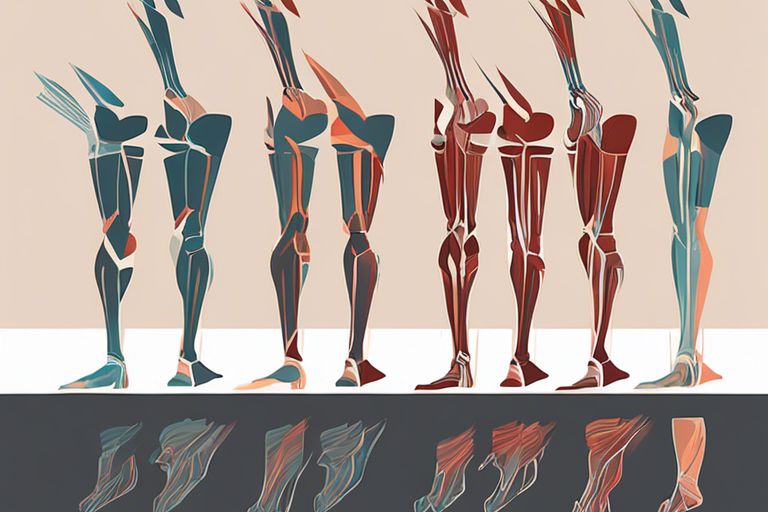Are you looking for a natural way to lower your cholesterol levels? Incorporating regular walking into your routine may be the answer you’ve been searching for. High cholesterol can lead to atherosclerosis, a dangerous condition that can increase your risk of heart disease and stroke. By engaging in physical activity such as walking, you can raise your levels of good cholesterol (HDL) while lowering your levels of bad cholesterol (LDL). Even moderate intensity walking has been shown to have a positive impact on cholesterol levels, making it an accessible and effective method for managing your health. In this blog post, we will explore the ways in which walking can aid in reducing cholesterol levels and improving your overall well-being.
Understanding Cholesterol
The human body produces cholesterol naturally to create hormones, Vitamin D, and substances that help with digestion. However, too much cholesterol can increase your risk of heart disease and stroke. It is essential to understand the different types of cholesterol and their impact on your overall health.
What is Cholesterol?
The body produces two types of cholesterol: LDL (low-density lipoprotein) and HDL (high-density lipoprotein). LDL cholesterol is often referred to as “bad” cholesterol because it can build up on the walls of your arteries and form plaque, which can lead to heart disease. HDL cholesterol, on the other hand, is known as “good” cholesterol because it helps remove LDL cholesterol from the arteries and carries it back to the liver to be broken down and removed from the body.
Good Cholesterol vs. Bad Cholesterol
When it comes to cholesterol, it’s important to maintain a balance between good and bad cholesterol. Having high levels of LDL cholesterol can increase your risk of heart disease, while higher levels of HDL cholesterol can lower your risk. Monitoring your cholesterol levels and making lifestyle changes, such as exercising regularly and eating a healthy diet, can help improve your cholesterol profile and reduce your risk of heart disease.
The Science of Walking and Cholesterol
Any form of physical activity can have a positive impact on your cholesterol levels. When you engage in regular exercise, including walking, your body undergoes a number of changes that can improve your cholesterol profile and decrease your risk of heart disease.
Physical Activity and Lipid Metabolism
Regular physical activity, such as walking, can help to raise levels of “good” HDL cholesterol. This type of cholesterol helps to remove other forms of cholesterol from your bloodstream, reducing the risk of plaque buildup in your arteries. Additionally, exercise can also lower levels of triglycerides, another type of fat in your blood, which can contribute to heart disease when elevated.
Studies on Walking and Cholesterol Reduction
Several studies have shown that walking can have a positive impact on your cholesterol levels. For example, a study published in the American Journal of Cardiology found that adults who walked 30 minutes a day experienced a significant increase in HDL cholesterol levels, as well as a decrease in triglyceride levels. Another study in the Journal of the American Medical Association found that walking briskly for 30 minutes a day can lower LDL cholesterol (the “bad” cholesterol) by 5% and reduce your risk of heart disease.
By incorporating regular walking into your routine, you can help to improve your lipid metabolism and reduce your risk of heart disease. These findings underscore the important role that physical activity, such as walking, can play in managing cholesterol levels and promoting cardiovascular health. It is clear that walking can be a simple yet powerful tool in your efforts to maintain healthy cholesterol levels and overall well-being.
Implementing Walking into Daily Life
Keep in mind that incorporating walking into your daily routine does not have to be complicated or time-consuming. There are several ways you can make it a regular part of your day without having to set aside a specific time for it. By integrating walking into your everyday activities, you can easily meet the recommended daily exercise goal and reap the benefits of improved cholesterol levels.
Developing a Walking Routine
When it comes to developing a walking routine, the key is to start small and gradually increase your activity level. Set achievable goals for yourself, such as taking a short walk around your neighborhood after dinner or parking farther away from your destination to get in some extra steps. Over time, you can work your way up to longer walks or more frequent sessions, depending on your fitness level and schedule.
Tips to Enhance the Effectiveness of Walking
There are several strategies you can use to enhance the effectiveness of your walking routine and boost its impact on your cholesterol levels. Incorporating interval training into your walks, where you alternate between periods of brisk walking and slower recovery periods, can help improve cardiovascular health and lower cholesterol. Additionally, incorporating hills or inclines into your walking route can increase the intensity of your workout and provide additional cardiovascular benefits.
- Adding strength training exercises, such as bodyweight squats or lunges, can help build muscle and further improve your cholesterol profile.
- Finally, don’t underestimate the power of consistency. Walking regularly and making it a habit is crucial for seeing long-term improvements in cholesterol levels.
Perceiving these tips and incorporating them into your walking routine can help you maximize the benefits of this simple yet powerful form of exercise.

Additional Considerations
After discussing the potential benefits of walking for reducing cholesterol levels, it’s important to consider additional factors that can impact your cholesterol management. While regular physical activity like walking is a great way to improve your cholesterol levels, there are other important elements to consider.
Dietary Factors in Cholesterol Management
When it comes to managing your cholesterol levels, your diet plays a crucial role. Including healthy fats, such as omega-3 fatty acids found in fish, nuts, and seeds can help lower your LDL (bad) cholesterol levels. Fiber-rich foods like fruits, vegetables, and whole grains can also help decrease LDL cholesterol. On the other hand, saturated and trans fats found in fried foods, processed snacks, and baked goods can raise your cholesterol levels. Additionally, reducing your intake of added sugars and refined carbohydrates can also contribute to better cholesterol management. Recognizing the impact of your diet on cholesterol levels is essential for overall heart health.
- Include healthy fats such as omega-3 fatty acids in your diet
- Opt for fiber-rich foods like fruits, vegetables, and whole grains
- Avoid saturated and trans fats found in processed snacks and baked goods
- Limit added sugars and refined carbohydrates in your diet
Importance of Medical Supervision and Regular Testing
It’s crucial to highlight the importance of medical supervision and regular testing when it comes to managing your cholesterol levels. Your healthcare provider can assess your risk factors and provide personalized recommendations for cholesterol management. Additionally, regular cholesterol screenings can help track your progress and identify any necessary adjustments to your treatment plan. Medical supervision and testing play a critical role in ensuring that you are effectively managing your cholesterol levels and reducing your risk of heart disease.
Can walking aid in reducing cholesterol levels?
Summing up, walking can indeed aid in reducing cholesterol levels. By engaging in regular brisk walking, you can increase your HDL cholesterol levels, which helps to remove harmful LDL cholesterol from your blood. Additionally, walking can also help you lose weight, which in turn can lower your overall cholesterol levels. Remember to make walking a regular part of your exercise routine and combine it with a healthy diet to maximize its cholesterol-lowering benefits. With consistency and dedication, you can improve your cholesterol levels and overall health through the simple act of walking.




